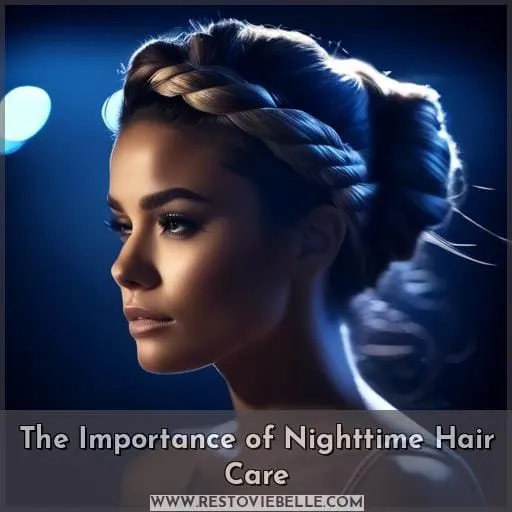This site is supported by our readers. We may earn a commission, at no cost to you, if you purchase through links.
 Embark on a nightly quest to shield your hair from the perils of tangles and breakage with a simple wrap.
Embark on a nightly quest to shield your hair from the perils of tangles and breakage with a simple wrap.
As you slumber, your hair endures the trials of friction and dryness, but with the right techniques, you can wake to smooth, lustrous strands.
Opt for the luxurious embrace of silk or the practical charm of satin to maintain your mane’s moisture and style.
Here’s how to wrap your hair at night, ensuring your locks are not only safeguarded but also primed for perfection by morning.
Yes, you can wrap your hair at night to keep it sleek and straight. Simply part your hair, smooth it around your head, secure with bobby pins if needed, and cover with a silk or chiffon scarf.
Table Of Contents
- Key Takeaways
- The Importance of Nighttime Hair Care
- Choosing the Right Material: Silk Vs. Satin
- Maintaining Your Wrap Through the Night
- Morning Routine for Unwrapped Hair
- Frequently Asked Questions (FAQs)
- How does hair wrapping affect dyed or chemically treated hair differently than natural hair?
- Can hair wrapping contribute to or exacerbate scalp conditions such as dandruff or dermatitis?
- What are the environmental impacts of producing silk and satin, and how do they compare?
- How can individuals with extremely short hair benefit from hair wrapping, and what techniques are recommended?
- Are there any specific considerations for hair wrapping in humid climates to prevent mold or mildew growth in the hair or on the wrap itself?
- Conclusion
Key Takeaways
- Wrapping hair at night with a silk or satin scarf can help reduce friction against the pillowcase, which in turn minimizes hair breakage, split ends, and frizz.
- Using a silk bonnet or pillowcase can help maintain hair’s moisture levels, preventing dryness and preserving the hair’s natural oils, which is beneficial for overall hair health and appearance.
- Proper wrapping techniques and securing the wrap with bobby pins or a silk bonnet can help preserve hairstyles, reduce the need for restyling, and keep hair smooth and tangle-free.
- Choosing the right material, such as silk or high-quality satin, is important for nighttime hair care as it can provide the benefits of reduced damage and moisture retention at various price points.
The Importance of Nighttime Hair Care
Wrapping your hair at night is a key step in maintaining healthy, smooth strands by morning. This practice not only protects your hair from the friction and damage caused by tossing and turning but also helps to preserve your hairstyle and retain moisture.
By incorporating this into your nightly routine, you’re taking a proactive approach to reduce breakage, frizz, and promote overall hair health.
Protecting Hair From Damage
Wrapping your hair at night is a crucial step in maintaining its health and preventing damage. This practice shields your strands from the types of damage that occur due to friction against pillowcases, such as breakage and split ends.
By wrapping your hair, you’re actively engaging in damage prevention, ensuring that your hair retains its moisture, which is often lost during sleep. This method not only helps in repairing damage by reducing stress on your hair but also in preventing long-term damage that can lead to hair loss.
Adopting hair protection techniques like wrapping can significantly contribute to the overall health of your hair, making it a vital routine for anyone looking to maintain smooth, healthy strands.
Preserving Moisture and Style
Wrapping your hair at night isn’t just about preventing damage; it’s a ritual that preserves your hair’s moisture and style.
- Choose the right materials: A silk bonnet or silk pillowcase can make a world of difference. Silk’s smooth texture reduces friction, helping to maintain your hairstyle and prevent moisture loss.
- Master wrapping techniques: Whether you’re using a silk hair scarf or a bonnet, proper wrapping can cater to different hair types, ensuring comfort and minimizing the chance of unravelling while you sleep.
- Enjoy the benefits: Not only does wrapping your hair provide comfort, but it also locks in moisture retention, keeping your hair hydrated and ready to face the day with minimal frizz.
Choosing the Right Material: Silk Vs. Satin
When it comes to wrapping your hair at night, choosing between silk and satin is crucial for maintaining smooth, frizz-free strands by morning.
Silk, a natural fiber, offers strength, breathability, and a luxurious feel, making it ideal for preserving your hair’s moisture and reducing damage.
On the other hand, satin, a weave that can be made from silk or synthetic materials, provides a similar smooth surface that’s gentle on your hair but often at a more affordable price.
Understanding the differences between these materials will help you make an informed decision on which is best for your nighttime hair care routine.
Benefits of Silk for Hair
Continuing from the importance of protecting your hair from damage and preserving its moisture and style, let’s delve into the silk benefits for your hair. Silk’s natural properties make it an ideal material for night hair care. It’s not just about avoiding tangles and frizz; silk also helps maintain your hair’s natural shine and reduces breakage.
When you wrap your hair in silk, you’re also ensuring that the silk moisture keeps your strands hydrated throughout the night.
Here’s a table comparing silk to other materials:
| Property | Silk | Cotton | Synthetic |
|---|---|---|---|
| Moisture | Retains | Absorbs | Varies |
| Frizz | Reduces | Causes | May cause |
| Breakage | Prevents | Can cause | May cause |
| Shine | Enhances | Dulls | Varies |
| Hair Health | Promotes | May harm | Neutral/Varies |
Silk scrunchies are another hair wrapping accessory that can be used to keep your hair secure without the risk of damage. They’re gentle on the hair and can prevent the breakage that often comes with elastic bands.
By incorporating silk into your night hair care routine, you’re taking steps towards mastery over your hair’s health and freedom from the damage caused by other materials.
When to Opt for Satin
While silk is often celebrated for its luxurious feel and hair-friendly properties, there are times when opting for satin might be more suitable for your hair care routine.
Satin, with its smooth surface, can offer similar benefits to silk, such as reducing friction and helping to prevent hair breakage and damage. If you’re on a budget, satin becomes an attractive option as it tends to be more affordable while still providing a gentle touch to your hair.
Satin pillowcases, scarves, and bonnets can serve as excellent alternatives to silk, especially for those seeking to maintain hair styling, moisture, and growth without the higher cost associated with silk products.
Whether you choose a satin scarf to wrap your hair at night or a satin cap to keep your curls intact, you’re making a smart choice for both your hair’s health and your wallet.
Maintaining Your Wrap Through the Night
Maintaining your wrap through the night is crucial for waking up with smooth, frizz-free hair.
To ensure your hair wrap stays secure, it’s important to choose the right materials and techniques that minimize slippage and unraveling.
By following a few simple steps, you can keep your hair protected and maintain its style, preventing the need for extensive styling in the morning.
Ensuring a Secure Fit
To ensure your hair wrap stays secure throughout the night, follow these steps:
- Choose the right scarf: Opt for silk to maintain hair beauty and moisture. Silk’s smooth texture reduces friction, preventing hair loss and aiding in hair regrowth.
- Bobby pin security: If you’re using a scarf, secure it with bobby pins every 2 inches. This helps to keep the wrap snug without relying solely on tying techniques.
- Tying techniques: Learn and apply different tying methods to ensure a snug fit that won’t come undone, securing without pins where possible.
- Hair accessories: Use hair accessories like a silk bonnet for a secure fit that locks in moisture, supports hair treatment, and won’t budge during sleep.
Minimizing Slippage and Unraveling
To minimize slippage and unraveling of your hair wrap through the night, it’s crucial to master a few techniques.
Start by ensuring your hair section thickness is just right—not too thick to avoid bobby pin tension, yet substantial enough to hold the wrap securely.
When folding your scarf, employ scarf folding techniques that complement your sleep position, reducing the chance of it coming undone.
For those with hair extensions, extra care is needed to prevent sleep wrinkles and maintain frizz reduction.
Don’t shy away from alternate fabrics if silk slips too easily; satin might offer a better grip.
Morning Routine for Unwrapped Hair
In the morning, after a night of protecting your hair with a wrap, it’s crucial to remove the wrap and pins gently to maintain the hair’s moisture and style.
Start by carefully untying or removing any accessories used to secure the wrap, being mindful not to pull or snag the strands.
Once the wrap is off, use your fingers or a wide-tooth comb to gently detangle and style your hair, preserving the smoothness and shape achieved overnight.
Removing Wraps and Pins Gently
In the morning, when it’s time to unveil your hair, approach wrap removal with care to avoid hair tension.
Begin by gently combing and parting your hair to loosen the wrap.
Carefully remove each bobby pin, paying attention to their placement to prevent snagging.
As you free your hair, use your fingers or a comb to guide it, minimizing disruption to your style.
Finally, remove any remaining hair accessories, savoring the smooth, frizz-free results of your nighttime efforts.
Preserving Hair’s Moisture and Style
To preserve your hair’s moisture and style for healthy strands, follow these morning routine steps:
- Gently remove wraps and pins to avoid damage
- Apply a leave-in conditioner to maintain moisture
- Seal in hydration with a light oil
- Style your hair as desired for the day ahead, ensuring protection and health overnight.
Frequently Asked Questions (FAQs)
How does hair wrapping affect dyed or chemically treated hair differently than natural hair?
Wrapping dyed or chemically treated hair at night helps prevent further damage and moisture loss. This is crucial for hair that’s already more porous and fragile than natural hair.
Can hair wrapping contribute to or exacerbate scalp conditions such as dandruff or dermatitis?
Hair wrapping, if done improperly, can indeed contribute to or exacerbate scalp conditions like dandruff or dermatitis.
Tight wraps or unclean materials can irritate the scalp, leading to increased symptoms.
It’s crucial to maintain scalp hygiene and use clean, gentle materials to avoid such issues.
What are the environmental impacts of producing silk and satin, and how do they compare?
Diving into the heart of our planet’s fabric, silk whispers tales of luxury but carries the weight of environmental concerns. Its production, a dance with nature, demands high energy and chemical use, while thousands of silkworms pay the ultimate price for a yard of this lustrous material.
Satin, on the other hand, mirrors silk’s elegance with a shadow of synthetic fibers like polyester, casting ripples of pollution through our waterways with every wash. As you cradle the world in your choices, remember, the path to sustainability is woven with threads of awareness and change.
How can individuals with extremely short hair benefit from hair wrapping, and what techniques are recommended?
Even with extremely short hair, wrapping at night can prevent frizz and maintain moisture.
Opt for a silk or satin cap that snugly fits your head, ensuring it’s gentle yet secure to avoid slipping off while you sleep.
Are there any specific considerations for hair wrapping in humid climates to prevent mold or mildew growth in the hair or on the wrap itself?
In humid climates, it’s crucial to ensure your hair and wrap are completely dry before bed to prevent mold or mildew.
Opt for breathable materials like silk, which wicks moisture away, and avoid leaving hair damp.
Regularly wash and dry your wrap to maintain hygiene and reduce moisture buildup.
Conclusion
Who wouldn’t want to wake up to effortlessly sleek and healthy hair every morning?
By wrapping your hair at night, you’re not just preserving its style; you’re embarking on a journey towards minimizing damage and maximizing moisture retention.
Whether you choose the luxurious feel of silk or the practicality of satin, you’re making a decision that benefits your hair’s health and appearance.
With a few simple steps before bed, you can ensure your locks remain smooth, hydrated, and ready to face the day.
So, why not give your hair the nightly care it deserves and embrace the transformation waiting for you by morning?









